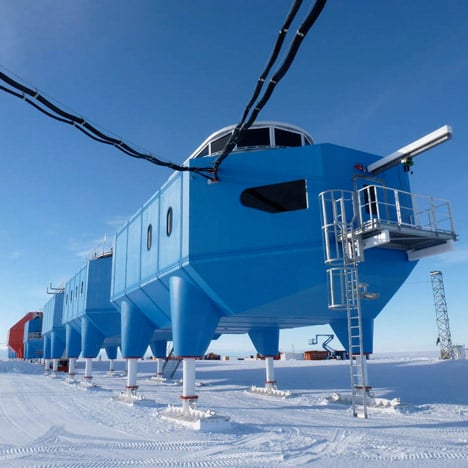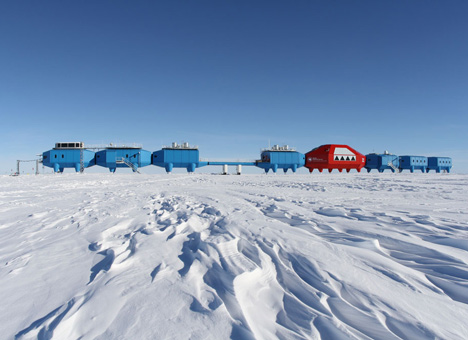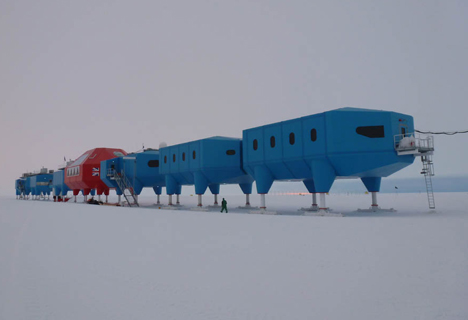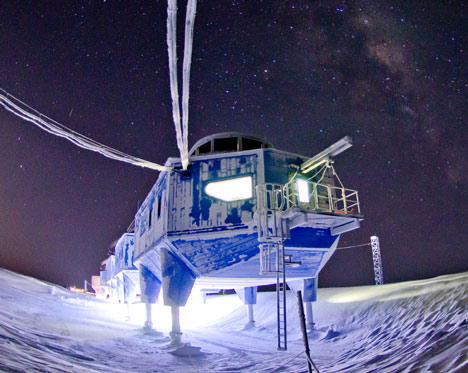World's first mobile research centre opens in Antarctica
News: the world's first mobile research facility, designed by British firm Hugh Broughton Architects, has officially opened on the floating Brunt Ice Shelf in Antarctica.

Above: photography by Hugh Broughton Architects
Top: photograph by station chef Antony Dubber
The Halley VI Antarctic Research Station is designed to be relocated inland to avoid being stranded on an iceberg as the ice shelf drifts towards the sea. Huge tractors towed the modules on their ski-like feet over a prepared ice track to their current site.
Designed by Hugh Broughton Architects with AECOM and constructed by Galliford Try for the British Antarctic Survey, the £25.8 million station is built to withstand extreme winter weather and is raised on hydraulically elevated feet to stay above the many metres of expected snowfall.

Above: photograph by British Antarctic Survey
Seven interlinking blue modules comprise the laboratories, offices, energy plants and bedrooms, while a central two-storey red module provides a social space.
The station will be home to up to 52 crew members in summer and just 16 in the three winter months of total darkness, when temperatures drop as low as -56C.

Above: photograph by Hugh Broughton Architects
A trial assembly of the station took place in 2007 in Cape Town, South Africa, after which it was dismantled and shipped to Antarctica. The complexities of assembling the structure in such a harsh environment meant the station has only just become fully operational, in time for the arrival of its summer crew.
The new centre replaces the 20-year-old Halley V facility and is the sixth to be built on the Brunt Ice Shelf, a 100m-thick area of ice against the Weddell Sea. Data collected from an earlier Halley station led to the discovery of the ozone hole in 1985.

Above: photo by Sam Burrell
This is the first project in Antarctica we've featured on Dezeen, but we have reported on plans for an airport in the Arctic Circle and a hotel made of ice in northern Sweden.
Last year we featured Hugh Broughton Architects' golden extension to a Tudor-style museum in Maidstone, England.
Here's the press release from the architects:
World’s first re-locatable research centre officially opens in Antarctica
Hugh Broughton Architects
Halley VI Antarctic Research Station – the world’s first re-locatable research facility – officially opens today, signalling a new dawn for 21st Century polar research. Opening one hundred years after Captain Robert Falcon Scott’s Antarctic expeditions, the new state-of-the-art research facility demonstrates the UK’s ambition to remain at the forefront of scientific endeavour.
Halley VI Antarctic Research Station is designed by Hugh Broughton Architects with AECOM and constructed by Galliford Try for the British Antarctic Survey (BAS). The project demonstrates an ability to create ground-breaking architecture characterised by a compelling concept, executed with fastidious attention to detail and exemplary levels of coordination. Pushing the boundaries of design in a life critical environment, it creates a beacon for sustainable living in the Polar Regions to draw attention to some of the most significant science conducted on our planet.
It is the product of an extraordinary and intense 8-year collaboration with BAS which began with an international competition-winning design for a modular facility. The challenge was to create excellent laboratory and living accommodation that was capable of withstanding extreme winter weather, of being raised sufficiently to stay above metres of annual snowfall, and of being relocated inland periodically to avoid being stranded on an iceberg as the floating ice shelf moves towards the sea.
The new research station, which replaces the 20-year old Halley V facility, is the sixth to be built on the floating Brunt Ice Shelf in a region that has established itself as an important natural laboratory for studying the Earth’s magnetic field and the near-space atmosphere. It was data from Halley that led to the 1985 BAS discovery of the ozone hole.
The £25.8 million station is built with an innovative concept featuring hydraulically elevated ski based modules, ensuring the station can be relocated inland periodically as the ice shelf flows towards the sea. The station combines seven interlinking blue modules used for bedrooms, laboratories, offices and energy plants, with a central two-storey red module featuring a double-height light filled social space. Interiors have been specially designed to support crew numbers ranging from 52 in summer to 16 during the three months of total darkness in winter when temperatures at the base drop as low as -56C.
Speaking at an event in London to celebrate the opening of the new station UK Minister for Universities and Science, David Willetts says:
“The new Halley Research Station is a triumph of British design, innovation and engineering. The UK’s world-class polar science community now has a unique, cutting edge suite of laboratories on the ice. The legacy of Captain Scott, together with our strong track record of scientific discovery in Antarctica, is set to continue in this excellent new facility.”